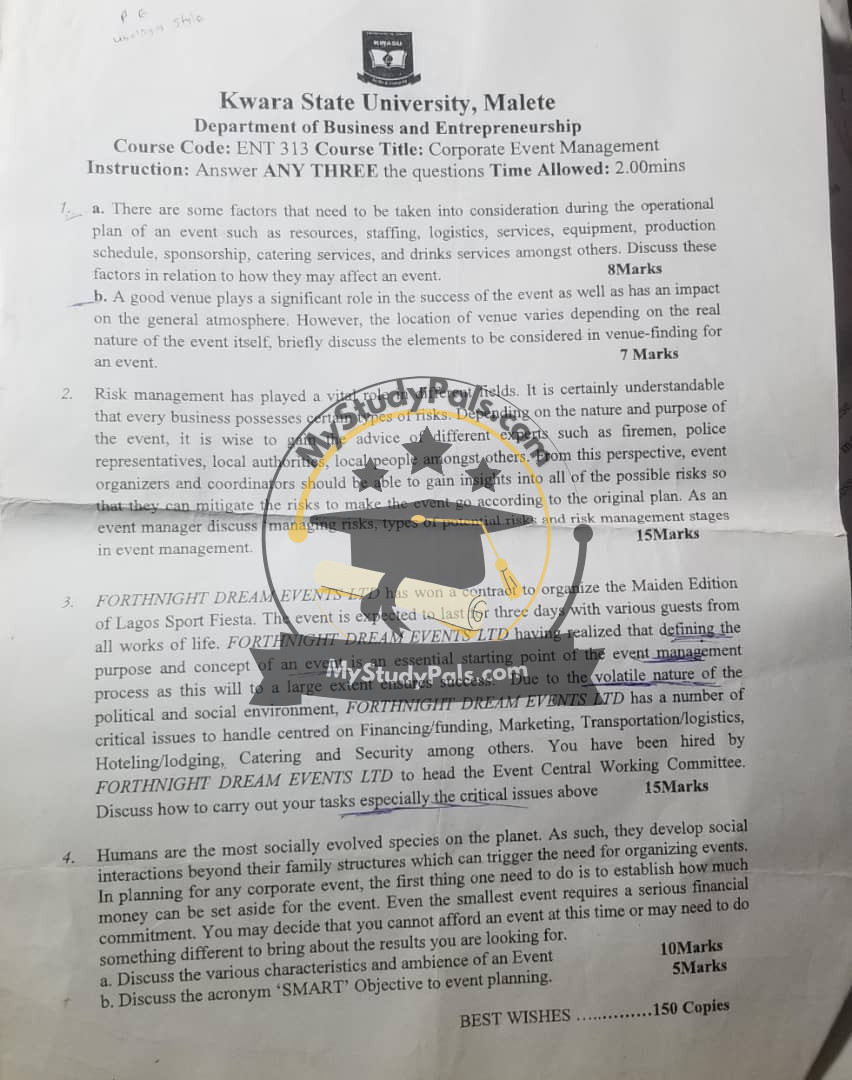ANWSER
Question 1:
Answer:
The operational plan of an event involves several critical factors that can significantly impact its success:
– Resources: Adequate financial and material resources ensure smooth execution. Shortages can lead to delays or compromises in quality.
– Staffing: Skilled and sufficient staff are essential for coordination, service delivery, and problem-solving during the event.
– Logistics: Efficient transportation, setup, and breakdown of equipment and materials are vital to avoid disruptions.
– Services: Reliable vendors for catering, security, and technical support contribute to attendee satisfaction.
– Equipment: Proper functioning of audio-visual, lighting, and other technical equipment is crucial for the event’s professionalism.
– Production Schedule: A detailed timeline ensures all tasks are completed on time and in the correct sequence.
– Sponsorship: Sponsors provide funding and resources, but their requirements must align with the event’s goals.
– Catering and Drinks Services: Quality and timely food and beverage services enhance the attendee experience. Poor service can lead to dissatisfaction.
Each factor must be carefully planned and managed to ensure the event runs smoothly and meets its objectives.
—
Question 2:
Answer:
When selecting a venue for an event, the following elements must be considered:
– Location: Proximity to attendees, accessibility, and safety are key. A remote location may deter participation.
– Capacity: The venue must accommodate the expected number of guests comfortably without overcrowding.
– Facilities: Availability of necessary amenities like restrooms, parking, Wi-Fi, and technical support.
– Ambience: The venue’s atmosphere should align with the event’s theme and purpose (e.g., formal, casual, or festive).
– Cost: The budget must cover rental fees, deposits, and any additional charges for services.
– Flexibility: The venue should allow customization to meet specific event needs, such as seating arrangements or branding.
– Regulations: Compliance with local laws, permits, and noise restrictions is essential to avoid legal issues.
Choosing the right venue ensures the event’s success by creating a conducive environment for attendees.
—
Question 3:
Answer:
Managing Risks in Event Management:
Risk management involves identifying, assessing, and mitigating potential risks to ensure the event’s success.
Types of Potential Risks:
– Financial Risks: Budget overruns or sponsorship withdrawal.
– Operational Risks: Equipment failure, staffing shortages, or logistical issues.
– Safety Risks: Accidents, medical emergencies, or security threats.
– Environmental Risks: Weather disruptions or natural disasters.
– Reputational Risks: Negative publicity or attendee dissatisfaction.
Risk Management Stages:
1. Risk Identification: List all possible risks (e.g., fire hazards, vendor cancellations).
2. Risk Assessment: Evaluate the likelihood and impact of each risk.
3. Risk Mitigation: Develop strategies to reduce risks (e.g., backups, insurance, trained staff).
4. Monitoring: Continuously track risks during the event and adjust plans as needed.
5. Post-Event Review: Analyze incidents and improve future risk management plans.
Proactive risk management minimizes disruptions and ensures a safe, successful event.
—
Question 4:
Answer:
As the head of the Event Central Working Committee for the Lagos Sport Fiesta, I would address the critical issues as follows:
1. Financing/Funding:
– Secure sponsorships from sports brands and local businesses.
– Create a detailed budget, allocating funds to key areas like logistics and marketing.
2. Marketing:
– Use social media, influencers, and traditional media to promote the event.
– Highlight unique attractions (e.g., celebrity appearances, competitions).
3. Transportation/Logistics:
– Arrange shuttle services for attendees and coordinate with local transport providers.
– Map out routes for smooth movement during the event.
4. Hoteling/Lodging:
– Partner with nearby hotels for discounted rates and block bookings.
– Provide clear information on accommodations to guests.
5. Catering:
– Hire reputable caterers offering diverse menus to cater to different dietary needs.
– Ensure timely food delivery and sufficient quantities.
6. Security:
– Collaborate with local police and private security firms for crowd control and safety.
– Implement emergency response plans and medical stations.
By addressing these issues systematically, the event will run smoothly and achieve its goals.
—
Question 5:
a. Characteristics and Ambience of an Event:
– Purpose: Clearly defined goals (e.g., networking, celebration, education).
– Theme: A cohesive design or concept that guides décor, attire, and activities.
– Atmosphere: Created through lighting, music, and layout to evoke desired emotions.
– Engagement: Interactive elements like games or discussions to involve attendees.
– Professionalism: High-quality organization and execution to leave a positive impression.
b. SMART Objectives in Event Planning:
– Specific: Clear goals (e.g., “Attract 500 attendees”).
– Measurable: Quantifiable outcomes (e.g., “20% increase in registrations”).
– Achievable: Realistic within budget and resources.
– Relevant: Aligns with the event’s purpose and audience.
– Time-bound: Set deadlines (e.g., “Secure sponsors by Month X”).
SMART objectives ensure focused and successful event planning.
—


